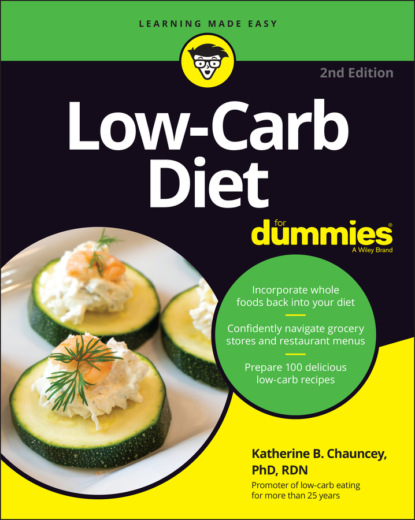dysfunction and infertility. Women with PCOS may benefit from a low-carb diet.
Heart disease
The importance of insulin resistance as a heart disease risk factor has been recognized. New treatment guidelines for the prevention of heart disease identify the cluster of abnormalities associated with insulin resistance as risk factors. Specifically, levels of triglycerides (a fat in the blood) have been added to the list of risk factors. High levels of triglycerides in your blood are not only related to your fat intake, but also to your intake of excess calories and carbohydrate.
High blood pressure
High blood pressure (hypertension) is one of the nation’s leading health problems. Forty-seven percent of adults are known to have high blood pressure and an estimated 100 million are at risk of developing it. High blood pressure greatly raises the risk of stroke, heart failure, and kidney disease. Current guidelines urge Americans to make diet and exercise changes designed to lower their blood pressure. Obesity is a major cause of hypertension. Approximately 78 percent of the high blood pressure cases in men and 65 percent in women can be directly attributed to obesity.
Compared with individuals with normal blood pressure, people with high blood pressure are relatively glucose intolerant. Insulin resistance is also a contributing factor to high blood pressure.
Inflammatory disease
Studies suggest that abdominal fat causes fat cells to release pro-inflammatory chemicals, which can make the body less sensitive to the insulin it produces by disrupting the function of insulin-responsive cells and their ability to respond to insulin. This is known as insulin resistance — the hallmark of type 2 diabetes. Having excess abdominal fat (that is, a large waistline) is known as central or abdominal obesity, a particularly high-risk form of obesity. Metaflammation is the metabolic inflammatory state associated with obesity. The condition is defined by low-grade chronic inflammation in metabolic tissues, including adipose (fat) cells, liver, brain, and pancreas. Weight loss and calorie restriction have shown to decrease inflammation and increase insulin sensitivity in people who have been medically advised to lose excess weight.
Arthritis and related conditions
Arthritis is a very common degenerative joint disease. It commonly affects the weight-bearing joints in the knees, hips, and lower back. The most common risk factors are obesity and a family history of the condition. Being obese causes increase wear and tear on the joints, which decreases your ability to walk or get up and down out of a chair. There are different forms of arthritis and excess weight affects them all. Arthritis and joint conditions related to obesity are estimated to cost more than $128 billion a year in healthcare.
Cancer
Consumption of excess calories, regardless of the source, increases the risk of breast, prostate, and colon cancer. But just as important is what you don’t eat. Diets full of whole foods such as fruits, vegetables, beans, whole grains, and low-fat dairy products are known to lower cancer risk. Dietary patterns that provide only the minimum servings of these foods increase cancer risk.
Gastroesophageal reflux disease (GERD)
Sometimes referred to as heartburn, gastroesophageal reflux disease (GERD) is much more extensive than heartburn. It has increased in incidence primarily due to obesity and the overconsumption of food. The intake of carbonated beverages and fatty and spicy foods aggravate the condition.
Determining Whether Low-Carb Dieting Is Dangerous
The question of safety has always arisen in regard to low-carb diets. That’s because some low-carb diet plans restrict all carbohydrate foods from the diet. Eliminating carbohydrate from your diet is almost impossible, but some diets require you to get down to 10 or 20 grams of carbs per day. These kinds of severe carbohydrate diets not only restrict vital nutrients from the diet but the body also loses vital nutrients. And as you can guess, when you lose vital nutrients, you can end up in poor health. Modern-day proponents of very-low-carb diets recognize this problem and are adamant in recommending vitamin and mineral supplements to cover the losses. Now think about it: Can a diet plan that requires supplements to replace lost nutrients from food be good?
Evaluating limits on carbs
Eating a healthy diet on a very-low-carb diet that restricts you to fewer than 50 grams of carbohydrate is impossible. If you tried, you’d be eliminating too many foods rich in vitamins, minerals, fiber, and cancer-fighters. Getting essential nutrients from foods is always better than getting it from supplements.
A moderately low-carbohydrate diet — such as the Whole Foods Weight Loss Eating Plan — includes 100 to 150 grams of carbohydrate per day. Recent nutrition guidelines say that 130 grams of carbohydrate per day is the minimum level needed for adequate brain function in children and adults. This level — also in-line with what the American Diabetes Association recommends — is the minimum to prevent loss of lean tissue from muscles and organs.
A high-carb diet, on the other hand, includes more than 250 grams of carbohydrate each day. That diet is appropriate for active people who are at a healthy weight (with a BMI between 20 and 25 — see Chapter 4 for more on BMI). No matter how many grams of carbs you eat every day, fruits, vegetables, whole grains, and legumes should be the main food sources of carbohydrates, with added sugar sources kept to a minimum.
To evaluate your own lifestyle and health risks to determine if a lower-carbohydrate diet may be good for you, turn to Chapter 4.
Getting Back to Basics: The Whole Foods Weight Loss Eating Plan
Very-low-carb diets, allowing no more than 15 to 30 grams of total carbohydrate per day, restrict many healthy foods and do not represent balanced lifetime nutrition. However, moderate restriction of carbohydrates — below the 60 percent recommended by the USDA, but not to the extreme — can produce positive benefits in many individuals.
